When it comes to buying a new washing machine, one of the key decisions consumers face is whether to choose a high efficiency (HE) washer or a regular washer. Both have their own sets of pros and cons in terms of features, performance, costs, and environmental impact.
High efficiency washers use advanced technology to clean clothes using significantly less water and energy compared to regular washers. They tend to cost more upfront but can lead to savings over time due to lower utility bills. Regular washers typically have a lower purchase price but use more resources to operate.
In this comprehensive guide, we will compare high efficiency and regular washers across a variety of factors to help you make an informed decision. We will look at how each type of washer works, compare cleaning performance and fabric care, evaluate costs over the long run, and examine environmental impacts.
- Understanding Different Types of Washers
- Benefits of High Efficiency Washers
- Benefits of Regular Washers
- How High Efficiency Washers Work
- Explaining the Technology Behind High Efficiency Washers
- Water and Energy Savings with High Efficiency Washers
- Understanding Load Capacity and Cycle Time
- How Regular Washers Work
- Traditional Washer Mechanisms and Features
- Water and Energy Usage with Regular Washers
- Understanding Load Capacity and Cycle Time
- Comparing Performance
- Cleaning Effectiveness
- Gentleness on Fabrics
- Noise and Vibration Levels
- Durability and Maintenance
- Cost Comparison
- Upfront Costs
- Operating Costs Over Time
- Long-Term Value and Savings
- Environmental Impact
- Water and Energy Consumption
- Use of Detergents and Chemicals
- End-of-Life Considerations
- Factors to Consider Before Making a Choice
- Household Size and Laundry Habits
- Space and Installation Requirements
- Availability of Resources (Water, Electricity, Detergents)
- Final Thoughts on Choosing the Right Washer
Understanding Different Types of Washers
Benefits of High Efficiency Washers
High efficiency (HE) washers offer a number of appealing benefits over regular washers:
- Save water: HE washers use up to 50% less water per load through improved tub design and advanced sensors.
- Save energy: Special motors and advanced controls allow HE washers to use 25-60% less energy.
- Get cleaner: HE washers clean clothes better by optimizing wash motions and using less water.
- Be gentler: With customized settings, HE washers are gentler on fabrics.
- Run more quietly: Improved insulation reduces noise levels significantly.
- Gain space: Many HE washers have a slimmer width to fit in tight spaces.
- Reduce waste: Less water and detergent is needed per load.
Benefits of Regular Washers
While lacking some advanced features, regular washers do have some advantages as well:
- Lower upfront cost: Regular washing machines tend to have a significantly lower purchase price.
- Use less detergent: Agitator provides added cleaning action so less detergent is needed.
- Handle heavy fabrics: The central agitator is ideal for cleaning bulky items.
- Fill up faster: Large water inlet allows tub to fill quickly.
- Easy to use: Simpler controls with fewer settings to choose from.
- Get a better rinse: Agitator provides added rinse action to remove more detergent residue.
How High Efficiency Washers Work
Explaining the Technology Behind High Efficiency Washers
High efficiency washers utilize advanced technology to clean clothes effectively while conserving significant water and energy compared to regular washers. Here are some key ways they achieve superior performance:
- Direct drive motors: These specialized motors connect directly to the drum, allowing very precise speed control for optimized cleaning.
- Inverter controls: Sophisticated electronics continually adjust motor speed and water levels to customize cleaning for each load.
- Low-water wash plates: These specially designed plates lift and drop clothes using less water for better cleaning.
- Advanced sensors: Multiple sensors monitor water levels, soil levels, load sizes and more to provide a customized clean.
- Improved tub design: Larger holes allow water and detergent to penetrate clothes more effectively.
- Precision balancing: Special counterweights let the drum spin very fast, extracting more water to reduce dryer time.
Together, these innovations allow high efficiency washers to get outstanding cleaning results while saving significant water and energy compared to regular top- and front-load washers.
Water and Energy Savings with High Efficiency Washers
High efficiency washers can lead to major resource savings over time. Here is how they compare:
- Water usage: HE washers use 12-25 gallons per load compared to 23-35 gallons for regular top-load washers.
- Energy usage: HE washers consume around 300 kWh per year compared to 530 kWh for regular top-load models.
- Detergent usage: Concentrated detergents mean less soap is wasted with HE washers.
These reduced inputs can lead to significant utility bill savings, along with reducing your environmental footprint. Cost savings may offset the higher purchase price over time.
Understanding Load Capacity and Cycle Time
High efficiency washers clean differently than regular washers, which impacts capacity and cycle length:
- Load capacity: HE tubs fit around 16-18 pounds normally, less than regular machines. But cleaning is more effective.
- Cycle length: HE washers take around 30-60 minutes on average due to gentler tumbling, optimized water levels and slower spin speeds.
So while HE washers take longer per load, the smart technology ensures this time is used effectively to get clothes clean while saving resources.
How Regular Washers Work
Traditional Washer Mechanisms and Features
Regular washing machines rely on conventional mechanisms and features to get clothes clean:
- Central agitator: This column in the tub rotates back and forth to rub clothes against each other to dislodge dirt.
- Higher water levels: The tub completely fills with water to allow clothes to move and soak effectively.
- Powerful motor: A rugged motor provides strong wash action via the central agitator.
- Simple controls: Users pick wash cycles and temperatures based on fabric type rather than sensor-detected load sizes.
- Noisy operation: The motor, agitator and moving parts create significant noise while running.
These traditional mechanisms provide adequate cleaning, but lack the advanced features and customization of high efficiency washers.
Water and Energy Usage with Regular Washers
Regular washers consume substantially more resources than high efficiency models:
- Water usage: 23Regular washers consume substantially more resources than high efficiency models:
- Water usage: 23-35 gallons per load compared to 12-25 gallons for high efficiency washers.
- Energy usage: Around 530 kWh per year compared to 300 kWh for high efficiency models.
- Detergent usage: Require significantly more detergent since they lack advanced sensors and wash motions.
The increased water, energy and detergent usage not only impacts the environment but also leads to higher operating costs over time through higher utility and detergent bills.
Understanding Load Capacity and Cycle Time
Regular top-load washers have some key differences in capacity and cycle length:
- Load capacity: Can fit 19-25 pounds normally, more than most high efficiency washers.
- Cycle length: Average cycle is about 40-60 minutes to allow for filling, soaking, agitating, and spinning.
So while regular washers can handle larger individual loads, the overall washing time is still comparable to high efficiency models in most cases.
Comparing Performance
Cleaning Effectiveness
When it comes to actually getting clothes clean, high efficiency and regular washers compare as follows:
- Soil removal: HE washers remove 5-15% more soil because of optimized wash motions, water levels and detergent use.
- Stain removal: Similar average stain removal, but HE washers are more consistent with sensor-detected loads.
- Odor removal: HE washers remove 6-15% more odor through enhanced rinses and higher spin speeds.
Overall, the smart technology in high efficiency washers leads to moderately better soil, stain and odor removal compared to regular washers.
Gentleness on Fabrics
In terms of wear and tear on clothes, high efficiency washers tend to be gentler:
- Fabric wear: Up to 15% less fabric wear since HE washers lack an agitator and have customized tumbling based on load size.
- Fading reduction: Colors stay vibrant for 5-10% more cycles with high efficiency washers.
So you can trust your delicate items to an HE washer. Just be sure to follow garment tag instructions as well.
Noise and Vibration Levels
High efficiency washers operate much more quietly than regular washers:
- Operational noise: HE washers produce 50-80% less noise during operation due to improved insulation.
- Vibration: Direct drive motors and precision balancing result in 70% less vibration.
This makes HE washers ideal for second floor laundry rooms or other living spaces, while regular washers tend to work best in basements or garages.
Durability and Maintenance
In terms of reliability and upkeep, washers compare as:
- Lifespan: Similar average lifespans around 10 years for both washer types.
- Repair frequency: HE washers tend to need fewer repairs thanks to less mechanical stress and vibration.
- Maintenance: While regular washers need more periodic maintenance, HE washers require special care of door seals, filters and gaskets.
Overall, while high efficiency washers cost more upfront, their advanced technology requires less repair over an average lifetime of use.
Cost Comparison
Upfront Costs
The higher purchase price of
The higher purchase price of high efficiency washers is a key consideration:
- HE top-load washer: $700-$1,200 depending on size, features and efficiency ratings.
- Regular top-load washer: $350-$850 for most standard models.
So expect to pay $200-$500 more for a high efficiency top loader. Front loaders have an even greater upfront cost difference. However, tax credits, rebates, and discounts from utility companies help make HE washers more affordable.
Operating Costs Over Time
While more expensive initially, high efficiency washers save money over a lifetime of use:
- Water and energy savings: Around $90/year for an HE washer compared to $165 for a regular washer.
- Detergent savings: Need up to 50% less HE detergent per wash which adds up over time.
Factoring in utility and detergent savings, an HE washer can pay for itself in under 5 years of typical use. Maintenance savings also add up for greater lifetime value.
Long-Term Value and Savings
Looking at total cost of ownership over a 10 year lifespan:
- High efficiency washer: Around $1,500 total considering purchase price, utilities and detergent.
- Regular washer: Approximately $1,800 total over 10 years.
So while regular washers carry lower purchase costs, high efficiency washers provide better value and significant lifetime savings that offset the higher initial investment.
Environmental Impact
Water and Energy Consumption
High efficiency washers lead to major resource savings over time:
- Gallons of water saved: 13,000 gallons after just 5 years of use compared to a regular washer.
- kWh of energy saved: 2,400 kWh after 5 years, saving household energy and avoiding pollution from power plants.
These savings will continue to accumulate each additional year you own an high efficiency washer.
Use of Detergents and Chemicals
HE washers also reduce detergent waste and pollution:
- HE detergent savings: Up to 30-50% less concentrated detergent needed per wash.
- Fewer chemical residues: Enhanced rinses leave behind fewer chemical residues in clothes and linens.
Using less detergent and chemicals is safer for families and reduces contamination of waterways.
End-of-Life Considerations
At end of life, washers compare as follows for sustainability:
- Recyclable materials: 70-90% of materials in both washer types can be recycled.
- Hazardous chemicals: HE washers contain less lead and mercury due to electronic advances.
So both washers can be recycled responsibly, with high efficiency models containing fewer hazardous legacy chemicals.
Factors to Consider Before Making a Choice
Household Size and Laundry Habits
When selecting a washer, consider:
- Number of loads per week: HE washers work best for 5+ loads. For less, a regular model may suffice.
- Load size: If washing mostly small loads, an HE washer utilizes less resources.
- Cycle length: Make sure an HE washer’s longer cycle won’t be an issue.
Also think about your laundry setup
Also think about your laundry setup. If doing multiple loads back-to-back, a regular washer’s faster refill may be preferred.
Space and Installation Requirements
Also factor in:
- Dimensions: Measure your space – some HE washers are slimmer while others are deeper.
- Electrical service: HE washers may need a 220V outlet installed by an electrician.
- Venting: Condensing HE washers don’t need external venting like traditional models.
Installation is simpler for regular washers. But HE washers offer flexible options too.
Availability of Resources (Water, Electricity, Detergents)
Consider if you have:
- Sufficient water pressure: HE washers require adequate pressure to operate properly.
- Reliable power supply: Any washer needs consistent electricity.
- Access to HE detergents: Make sure to find these specialized formulations locally.
HE washers need extra resources. But smart controls help them adapt to real-world conditions too.
Final Thoughts on Choosing the Right Washer
When choosing between high efficiency and regular washers, there are many factors to weigh based on your household’s unique needs and priorities.
While HE washers carry a higher upfront investment, they provide superior cleaning performance plus long-term savings on utilities and detergent. Their advanced technology also makes them gentler on fabrics while reducing environmental impact.









